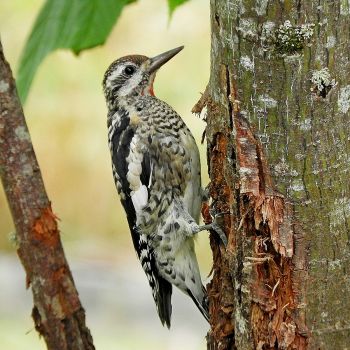- Sphyrapicus varius
Identification
- At 19-21 cm (7½-8¼ in) length and 41-62 g weight, a medium-sized woodpecker
- Bold white patch on the side of the body (shows in flight)
- Like all woodpeckers, has zygodactyl feet and a sharp, chisel-like beak. Unlike most other woodpeckers, the tongue has a brush-like (as opposed to barbed) tip.
Adult
- Red crown and (on male) throat (white throat on female). Some females have an all black crown or with few buff spots.
- Black and white patterning on body
- Pale yellow belly (from which the bird is named)
Juvenile
- Brown stripes on head
- Brown breast and flanks
Similar species
The white patch on the wing coverts sets sapsuckers apart from all other woodpeckers.
Male Yellow-bellied Sapsuckers are distinguished from male Red-naped Sapsuckers only by the red nape spot and incomplete frame to red throat of Red-naped Sapsucker.
Females are somewhat easier to distinguish, as they differ in these characters, as well as having quite different throat patterns (white in Yellow-bellied, but red and white in Red-naped Sapsucker). Red-breasted Sapsucker is more easily distinguished by the extensively red head and upper breast.
The post-juvenile molt is later than other sapsuckers, extending until March; any sapsucker still in juvenile plumage after late fall must be a Yellow-bellied[3].
Beware of rare hybrid Yellow-bellied x Red-naped Sapsuckers and Yellow-bellied x Red-breasted Sapsuckers, and the occasional Yellow-bellied Sapsucker which may show a red nape spot.
Distribution
Found throughout much of northern and eastern North America. It is much more strongly migratory than most woodpeckers, breeding in the taiga forests of Canada (west to near the Alaskan border) and the northeastern United States, and wintering from the southeastern United States south through Mexico to Panama, and on the larger Caribbean islands.
Also casual in winter west to the California coast.
There are a few records of vagrants in Britain, Ireland, and Iceland.
Taxonomy
This is a monotypic species[1].
Habitat
Found in early-successional/mixed conifer forests. Prefers quaking aspen, birches, and maples for nesting and feeding.
Behaviour
Diet
Seemingly prefers certain trees for feeding, most notably birches and maples, as well as some pines. Drills small "wells" in the bark to reach sap. Appears to have special enzymes in its saliva which keep the sap flowing for some time, as the wells would seal themselves rapidly under normal conditions. Sapsuckers also fairly regularly eat insects (mostly through fly-catching), especially those which come to feed from their sap wells. Many other species of birds (including woodpeckers, warblers, and hummingbirds), as well as insects and mammals (such as squirrels and chipmunks), visit these wells for a sweet treat.
Breeding
Nest is a large cavity excavated in a deciduous tree, which can be reused for several years. Mating is for life with the same partner.
They sometimes hybridize with Red-naped Sapsuckers and Red-breasted Sapsuckers where breeding ranges overlap.
Movements
Migratory. They travel in family parties well south of their breeding areas.
Vocalisation
A nasal meow
In Culture
This bird is widely known for its lengthy and humorous name. This bird is also the symbol of the Cornell Lab of Ornithology, and of their laboratory at Sapsucker Woods, Ithaca NY.
References
- Clements, J. F., T. S. Schulenberg, M. J. Iliff, S. M. Billerman, T. A. Fredericks, B. L. Sullivan, and C. L. Wood. 2019. The eBird/Clements Checklist of Birds of the World: v2019. Downloaded from http://www.birds.cornell.edu/clementschecklist/download/
- Del Hoyo, J, A Elliot, and J Sargatal, eds. 2002. Handbook of the Birds of the World. Volume 7: Jacamars to Woodpeckers. Barcelona: Lynx Edicions. ISBN 978-8487334375
- Sibley, DA. 2000. The Sibley Guide to Birds. New York: Alfred A. Knopf. ISBN 978-0679451228
- BF Member observations
Recommended Citation
- BirdForum Opus contributors. (2025) Yellow-bellied Sapsucker. In: BirdForum, the forum for wild birds and birding. Retrieved 28 April 2025 from https://www.birdforum.net/opus/Yellow-bellied_Sapsucker
External Links
GSearch checked for 2020 platform.1








